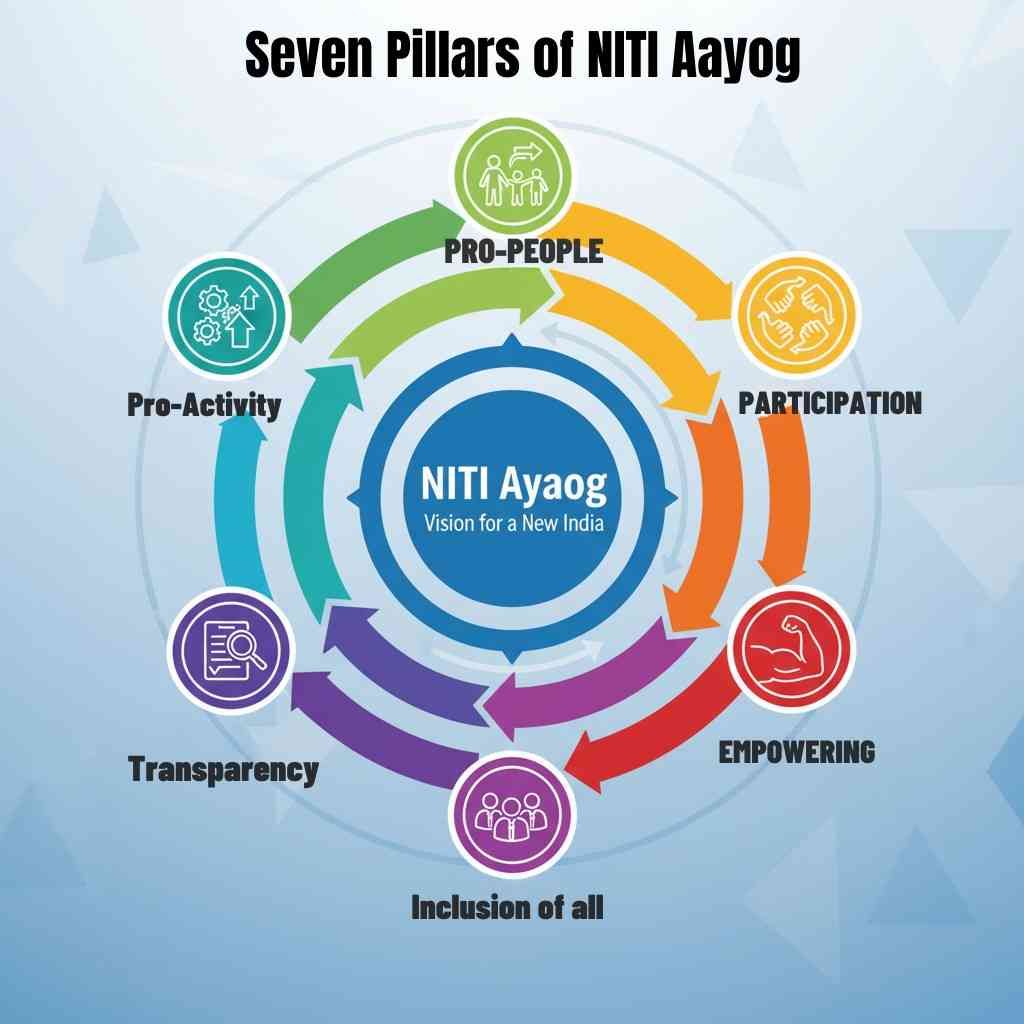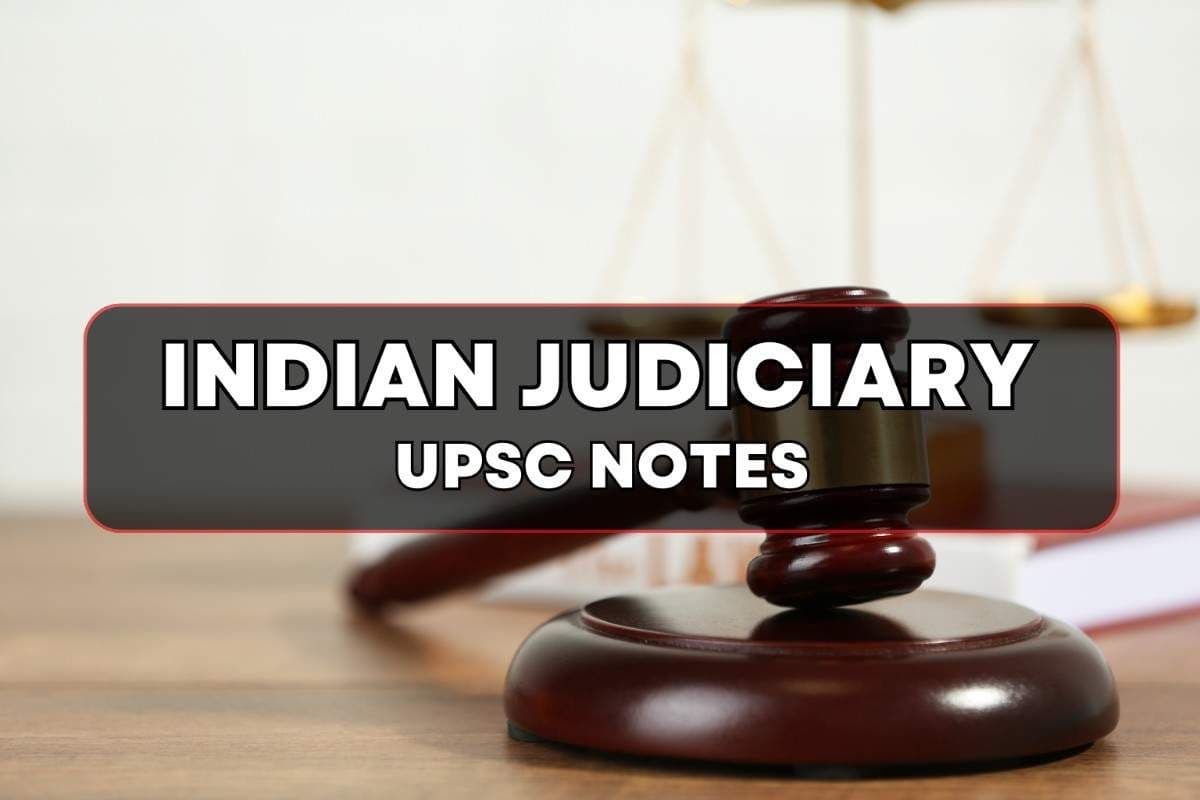NITI Aayog: Composition, Functions, Objectives & Major Initiatives for UPSC Exam
Sep, 2025
•4 min read
NITI Aayog is India’s top policy think tank. It promotes Centre-State cooperation, innovation, and evidence-based guidelines. For the UPSC exam, it is important for Prelims (structure, roles) and Mains (federalism, policy impact).
Here, we will cover key facts, classifications, recent developments, and details about NITI Aayog for the UPSC.
What is NITI Aayog?
NITI Aayog (National Institution for Transforming India) is the Government of India’s premier policy think tank established on 1st January 2015 to replace the Planning Commission and foster cooperative federalism, innovation, and evidence-based governance.
Key Facts
- Established: 1 January 2015, by replacing the Planning Commission.
- Chairperson: Prime Minister of India
- Mandate: Strategy formulation, policy vision, and monitoring of national development.
- Approach: Bottom-up cooperative federalism and competitive federalism.

Composition of NITI Aayog
The leadership of NITI Aayog combines expertise from both the Centre and the States to ensure balanced decision-making.
- Chairperson: Prime Minister of India
- Vice Chairperson: To be appointed by the Prime Minister
- Governing Council: Comprises Chief Ministers of all States and Lieutenant Governors of Union Territories.
- Regional Council: Formed to address specific regional issues, comprising the Chief Ministers and the Lieutenant Governors, chaired by the Prime Minister or his nominee.
- Ad hoc Membership: Two members in an ex officio capacity from leading research institutions on a rotational basis.
- Ex-Officio Members: A Maximum of four members from the Union Council of Ministers nominated by the Prime Minister.
- Chief Executive Officer (CEO): Appointed by the Prime Minister for a fixed tenure, holding the rank of Secretary to the Government of India.
- Special Invitees: Experts and specialists possessing domain knowledge, nominated by the Prime Minister.
This composition ensures broad representation and expert guidance for effective policy formulation and implementation.
Also read: Comptroller and Auditor General of India (CAG) – Complete UPSC Notes
Functions of NITI Aayog
NITI Aayog undertakes several core functions to guide India’s development agenda.
- Policy formulation across sectors with long-term strategic vision.
- Monitoring and evaluation of government programmes, offering feedback for improvements.
- Conducting research, data analysis, and promoting innovation ecosystems.
- Engaging States and Union Territories in collaborative policy-making and peer learning.
- Advising on institutional reforms, technology adoption, and skill enhancement.
- Publishing indices, reports, and policy briefs to share knowledge.
- Facilitating state-specific support through initiatives like “NITI for States” and the Aspirational Districts Programme.
- Coordinating with international agencies, academia, and industry for strategic partnerships.
Also read: Election Commission of India: UPSC Notes
Importance of NITI Aayog
NITI Aayog is crucial for shaping India’s long-term development by:
- Acting as a high-quality policy advisory body backed by rigorous research.
- Promoting cooperative federalism, ensuring States have an equal voice.
- Fostering innovation through flagship programs like the Atal Innovation Mission.
- Monitoring major schemes and ensuring effective implementation.
Objectives of NITI Aayog
Aligned with India’s vision to become a $30-trillion economy and a developed nation by 2047, NITI Aayog aims to:
- Create a shared vision of national development priorities.
- Strengthen technology upgradation and capacity building for better programme delivery.
- Monitor and evaluate government initiatives to enhance outcomes.
- Promote research, innovation, and strategic policy across sectors.
Also read: Securities and Exchange Board of India (SEBI): Powers, Functions, & Recent Reforms
Difference Between NITI Aayog and Planning Commission
Here is the key difference between NITI Aayog and the Planning Commission:
| NITI Aayog | Planning Commission |
|---|---|
| Established in 2015 | Established in 1950 |
| Policy think tank and advisory body | Centralised planning authority |
| Bottom-up, cooperative federalism | Top-down, centralised planning |
| Does not allocate funds | Allocated funds to States and Ministries |
| Active participation through the Governing Council. | Limited role, mainly through the National Development Council. |
| Dynamic strategies (15-year vision, 7-year plan) | Fixed Five-Year Plans |
| Extra-constitutional | Extra-constitutional |
Major Initiatives of NITI Aayog
NITI Aayog has launched transformative initiatives across sectors to drive India’s growth.
- Frontier Tech Hub for advanced technology promotion.
- NITI for States for customised state engagement.
- LiFE (Lifestyle for Environment) campaign.
- NDAP (National Data and Analytics Platform).
- Shoonya aims to achieve zero-emission mobility targets.
- E-Amrit for digital health infrastructure.
- Women Entrepreneurship Platform to support women-led businesses.
- Methanol Economy to promote alternative fuels.
- India Policy Insights for geo-visual data and evidence-based policy.
Multiple Choice Questions
QUESTION 1
Easy
The concept of “Competitive Federalism” is promoted by:
Select an option to attempt
Significance of NITI Aayog
By redefining governance and policy-making, NITI Aayog:
- Strengthens Centre-State collaboration for region-specific solutions.
- Enhances transparency and accountability via performance indices.
- Accelerates progress towards Sustainable Development Goals.
- Serves as a think tank that fosters sectoral research and innovation.
Drawbacks and Criticisms of NITI Aayog
Despite its strategic vision, NITI Aayog faces certain constraints:
- Lacks statutory authority to allocate funds directly.
- Functions only in an advisory capacity without enforcement powers.
- Relies on inter-ministerial coordination for implementation.
- Has limited public visibility of internal evaluations and data.
UPSC Mains Previous Year Question Practice
How are the principles followed by the NITI Aayog different from those followed by the erstwhile Planning Commission in India? (2018)
Evaluate Your Answer Now!Conclusion
NITI Aayog marks a paradigm shift from centralised planning to an inclusive, evidence-driven framework. Its success depends on continued collaboration with States, robust monitoring mechanisms, and empowerment to turn policy advice into tangible outcomes.
Elevate Your UPSC Prep with SuperKalam!
Discover SuperKalam, your Personal Super Mentor for targeted UPSC preparation. Unlock unlimited MCQs, practice mains answers with Instant Mains Answer Evaluation, and real-time performance tracking.
Explore SuperKalam's Resources and set yourself on the path to success!


